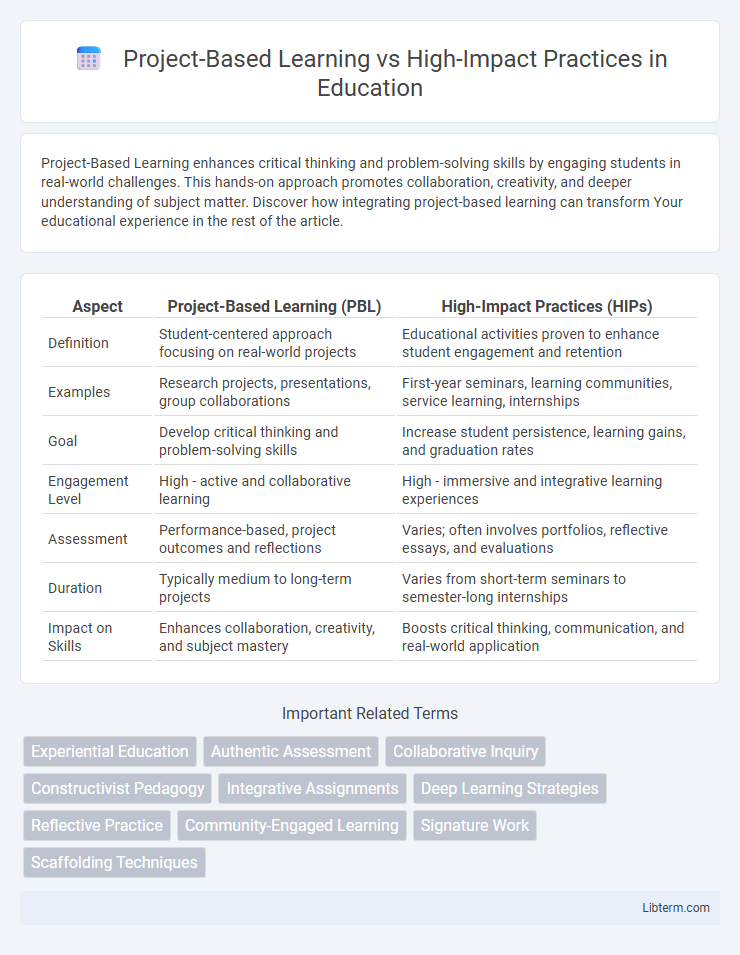Project-Based Learning enhances critical thinking and problem-solving skills by engaging students in real-world challenges. This hands-on approach promotes collaboration, creativity, and deeper understanding of subject matter. Discover how integrating project-based learning can transform Your educational experience in the rest of the article.
Table of Comparison
| Aspect | Project-Based Learning (PBL) | High-Impact Practices (HIPs) |
|---|---|---|
| Definition | Student-centered approach focusing on real-world projects | Educational activities proven to enhance student engagement and retention |
| Examples | Research projects, presentations, group collaborations | First-year seminars, learning communities, service learning, internships |
| Goal | Develop critical thinking and problem-solving skills | Increase student persistence, learning gains, and graduation rates |
| Engagement Level | High - active and collaborative learning | High - immersive and integrative learning experiences |
| Assessment | Performance-based, project outcomes and reflections | Varies; often involves portfolios, reflective essays, and evaluations |
| Duration | Typically medium to long-term projects | Varies from short-term seminars to semester-long internships |
| Impact on Skills | Enhances collaboration, creativity, and subject mastery | Boosts critical thinking, communication, and real-world application |
Introduction to Project-Based Learning and High-Impact Practices
Project-Based Learning (PBL) engages students in in-depth exploration of real-world problems, fostering critical thinking and collaborative skills through active, hands-on experiences. High-Impact Practices (HIPs) are educational strategies proven to significantly improve student retention, learning, and engagement by involving immersive, challenging activities like internships, service learning, and undergraduate research. Both approaches emphasize experiential learning, but PBL centers on extended projects while HIPs encompass a broader range of transformative academic experiences.
Defining Project-Based Learning: Core Principles
Project-Based Learning (PBL) centers on student-driven inquiry where learners engage in complex, real-world projects to develop deep content knowledge and critical thinking skills. Core principles of PBL include sustained inquiry, collaboration, reflection, and public product creation, fostering authentic learning experiences that connect theory to practice. Unlike High-Impact Practices, which encompass a broader range of educational strategies, PBL emphasizes hands-on problem solving and iterative learning cycles to enhance student motivation and knowledge retention.
Understanding High-Impact Practices: Key Features
High-Impact Practices (HIPs) are educational strategies proven to increase student engagement and retention, including first-year seminars, learning communities, undergraduate research, and service learning. These practices emphasize deep interaction with faculty, active collaboration with peers, and real-world application of knowledge, fostering critical thinking and problem-solving skills. HIPs are designed to be inclusive and scalable, enhancing student learning outcomes across diverse disciplines and demographics.
Similarities between Project-Based Learning and High-Impact Practices
Project-Based Learning and High-Impact Practices both emphasize experiential learning through immersive, student-centered activities that foster critical thinking and real-world problem-solving skills. Both approaches engage students in collaborative projects and reflective practices, enhancing retention and deeper understanding of course material. They share a focus on active engagement, interdisciplinary integration, and development of practical skills that prepare students for professional success.
Differences in Implementation and Structure
Project-Based Learning (PBL) emphasizes student-driven projects centered on real-world problems, typically structured around interdisciplinary collaboration and iterative feedback cycles. High-Impact Practices (HIPs) encompass a broader range of educational experiences, including service learning, first-year seminars, and undergraduate research, designed to engage students more deeply with faculty and peers through structured, high-engagement activities. Implementation of PBL requires sustained project timelines and learner autonomy, whereas HIPs are integrated into curricula as discrete, high-impact activities linked to measurable outcomes and institutional goals.
Impact on Student Engagement and Motivation
Project-Based Learning (PBL) significantly enhances student engagement by fostering active participation through real-world problem solving, which boosts intrinsic motivation and deepens understanding. High-Impact Practices (HIPs), including collaborative assignments and undergraduate research, consistently lead to higher retention rates and improved grades by promoting sustained intellectual effort and a sense of community. Combined, PBL and HIPs create dynamic learning environments that increase motivation and engagement, resulting in stronger academic performance and long-term student success.
Evidence-Based Outcomes and Effectiveness
Project-Based Learning (PBL) demonstrates significant evidence-based outcomes in improving critical thinking, problem-solving skills, and student engagement through real-world application of knowledge. High-Impact Practices (HIPs), such as undergraduate research, service learning, and collaborative assignments, are backed by extensive research showing enhanced retention rates, higher GPAs, and greater post-graduate success. Comparative studies reveal that both PBL and HIPs increase academic achievement and student satisfaction, but HIPs often provide a broader scope of integrative experiences that contribute to long-term educational effectiveness.
Challenges and Limitations of Each Approach
Project-Based Learning often faces challenges such as uneven student participation, limited real-time feedback, and resource-intensive planning that can strain educators. High-Impact Practices encounter limitations including scalability issues, the need for extensive faculty training, and potential exclusion of students lacking prerequisite skills or support. Both approaches require careful implementation to address equity concerns and optimize student engagement and learning outcomes.
Best Practices for Integrating Both Strategies
Integrating Project-Based Learning (PBL) with High-Impact Practices (HIPs) maximizes student engagement and deep learning by aligning collaborative projects with experiential activities like internships and service learning. Effective strategies include designing interdisciplinary, real-world projects that foster critical thinking and complement HIPs such as undergraduate research and learning communities. Assessing outcomes using reflective assignments and performance-based evaluations ensures meaningful synthesis of knowledge and skill development.
Conclusion: Choosing the Right Approach for Educational Success
Project-Based Learning fosters critical thinking and collaboration through real-world problem solving, while High-Impact Practices emphasize student engagement and retention via structured, research-backed activities. Selecting the appropriate approach depends on educational goals, institutional resources, and student needs, ensuring alignment with desired learning outcomes. Integrating elements of both can maximize educational success by combining hands-on experience with evidence-based strategies.
Project-Based Learning Infographic

 libterm.com
libterm.com